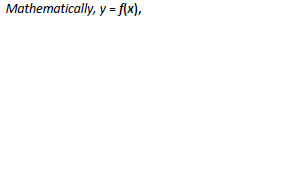A production function describes the technical relationship that transforms inputs (resources) into outputs (commodities

where y is an output and x is an input.
All values of x greater than or equal to zero constitute the domain of this function
Production is also defined as producing goods which satisfy some human want.
(i) Fixed Input
The cost of production of goods and services that does not change in the short run. It is a factor of production that remains fixed/unchanged (constant) for a certain level of output.
Examples: factory, building, equipment, or other capital used in production
(ii) Variable input
These are inputs whose supply is in the short-run or is that which changes with changes in output.
Example: labour or workers who work in the factory or operate the equipment.
In the long –run all inputs (both variable & fixed) are variable
(iii) Short run:
A production period of time in which at all inputs in the production process are fixed, meaning the quantity of output itself is fixed. Also termed market period, the short run exists if the period is so short that no additional production is possible. In other words, the good have been produced all that remains is to sell them. In the short-run, therefore, production of a commodity can only be increased by increasing the use of only variable inputs like labour and raw materials
(iv) Long run:
A production time period in which all inputs are variable, including those under control of the firm and those beyond the control of the firm. During this period, not only are the labour, capital, land, and entrepreneurship inputs variable, but also are key production inputs such as government rules, technology, and social customs.
marto answered the question on
April 16, 2019 at 12:33